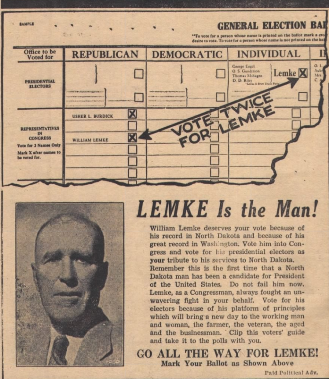Doug Burgum and a Brief History of North Dakota Presidential Candidates
Burgum is the first candidate to launch a bonafide major party White House campaign from the Peace Garden State
 Doug Burgum, North Dakota’s understated billionaire governor, may not have made as many headlines as another Republican 2024 presidential contender who officially entered the GOP race on Wednesday.
Doug Burgum, North Dakota’s understated billionaire governor, may not have made as many headlines as another Republican 2024 presidential contender who officially entered the GOP race on Wednesday.
But while Mike Pence may have received more ink, Burgum’s campaign is also noteworthy as he became the first North Dakotan to actively seek a major party presidential nomination.
Over the last 133 years since North Dakota achieved statehood, only a few residents have been mentioned in the context of presidential elections.
At the dawn of the presidential primary in 1912, the state’s first Democratic Governor, John Burke, was a favorite son candidate in the first-in-the-nation North Dakota primary held on March 19th.
Burke, in his third and final term, was the state’s only Democratic governor from statehood until 1934 when newspaperman Thomas Moodie was elected.
All the drama in the state that day was on the Republican ballot with Wisconsin U.S. Senator Robert La Follette defeating former President Teddy Roosevelt by nearly 20 points and President William Howard Taft garnering only 3 percent of the vote.
Nearly 60,000 votes were cast in the GOP primary while Burke won 9,357 votes unopposed in the Democratic contest.
Burke did not seek or receive any convention votes for the presidency but did win 386 votes for vice-president, losing to Indiana Governor Thomas Marshall on the second ballot.
No other non-fringe candidate from North Dakota has run for president from either major party.

In 1936, former Republican state Attorney General and sitting at-large U.S. Representative William Lemke accepted the nomination of the Union Party in June.
Lemke, who narrowly lost a recall election as Attorney General in 1921 less than a year into office, had roots in the Nonpartisan League and was a Farmer-Labor nominee for U.S. Senator in 1926.
Lemke received 1.9 percent of the nationwide vote in 1936, peaking at 13.4 percent in his home state and winning more than five percent in four others (Minnesota, Massachusetts, Rhode Island, and Oregon).
However, Lemke was simultaneously reelected to one of the state’s two at-large U.S. House seats as a Republican that cycle. He would ultimately serve eight nonconsecutive terms in the chamber (1933-1941, 1943-1950).
As for Burgum, it should be noted that his pathway to the governorship in 2016 was also unexpected. He placed a distant third at the state GOP endorsing convention with less than 10 percent but stayed in the race and just three months later defeated the party-backed sitting state Attorney General Wayne Stenehjem by a decisive 21 points en route to a blow-out general election victory.
Follow Smart Politics on Twitter.

And then there is only Nevada remaining – whatever the duration of the candidacy of Governor Burgum.
I concur – Paul Laxalt’s 4-month 1988 exploratory committee run does not quite make the cut.
The campaign announcements from Pence, Christie, and Burgum this week have increased the number of current or former governors running for the 2024 GOP nomination to six [the other three being Haley, Hutchinson, and DeSantis]. This ties the mark set in 2012 [Johnson, Pawlenty, Romney, Huntsman, Roemer, Perry], but falls short of the nine governors who ran in the 2016 GOP primary [Huckabee, Pataki, Perry, Bush, Jindal, Christie, Walker, Kasich, Gilmore]. This does, though, surpass the four governors who ran on the Democratic side in 2020 [Inslee, Hickenlooper, Bullock, Patrick].
The dearth of governors in that huge field of 2020 Democratic candidates was such that, in October 2019, there were more governors challenging Trump for the Republican nomination [Weld and Sanford] than there were competing for the Democratic nomination [Bullock].
By contrast, the 2020 Democratic field featured 9 sitting or former U.S. senators, and 4 out of the 5 major Democratic candidates in 2016 were U.S. senators. Meanwhile, GOP U.S. senators running for president reached a peak in 2016 with five, but only one each have run in 2012 [Santorum] and 2024 [Scott].
Burgum’s entry in this race means there is the potential for two billionaires to share a presidential debate stage for only the second time in history, after Steyer and Bloomberg did so exactly once in 2020. However, it remains to be seen whether Burgum will meet the requirements in order to be eligible to debate, and it is possible that Trump will skip the debates altogether anyway.
[…] Doug Burgum and a Brief History of North Dakota Presidential Candidates […]
One day a North Dakotan will manage to make onto a presidential ticket (almost assuredly on a *Republican* line).
For this year, though, Governor Burgum must feel relieved, even giddy, that he was passed over for that spot. Not only has Senator ‘Shady’ Vance been bombarded with unfavorable media coverage (his lengthy Robert Bork-esque ‘paper trail’ of his public life has not helped, to say the least) but even has been ‘downgraded’ in favor of “radical left” ex-Democrat RFK jr (‘Trump – Kennedy for 2024’). As well, he might have faced occasional comparison to that betted-known “Doug” (would-be ‘First Gent’ Doug Emhoff).
One hopes 2027~2028 will be more conventional, more calm – for ex-Governor Burgum and any other aspirant indeed.